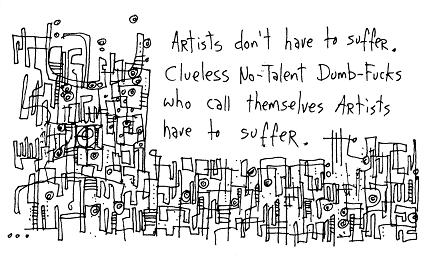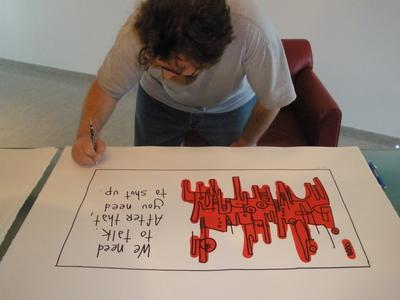Image by Hugh MacLeod
For many of you, Hugh MacLeod will need no introduction. Others will be intrigued to discover a creative entrepreneur who has built an unlikely and utterly idiosyncratic business based on “cartoons drawn on the back of business cards”.
Hugh’s gapingvoid blog has enabled him to achieve success as a cartoonist and artist without going down the traditional gallery or newspaper routes. It has also been the launchpad for a series of creative marketing ventures, including Savile Row tailoring at English Cut, South African wines from Stormhoek, the feature film Hallam Foe, and work for Microsoft and Dell.
Hugh’s recent ventures include limited edition prints of his work, a forthcoming book, Ignore Everybody and his Crazy Deranged Fools newsletter.
1. You’re known as a cartoonist, artist, marketer and blogger – which of those titles are you most comfortable with?
I prefer the term, “Cartoonist”. “Marketer” and “Blogger” are peripheral. I never liked calling myself an “Artist”. I think History decides if you’re an artist or not, not yourself.
Image by Hugh MacLeod
2. A lot of artists and creative types see marketing as an evil necessity – or just plain evil. What would you say to them?
“Artists cannot market” is complete crap. Warhol was GREAT at marketing. As was Picasso and countless other “Blue Chips”. Of course, they’d often take the “anti-marketing” stance as a form of marketing themselves. And their patrons lapped it up.
The way artists market themselves is by having a great story, by having a “Myth”. Telling anecdotal stories about Warhol, Pollack, Basquiat, Van Gogh is both (A) fun and (B) has a mythical dimension… if they didn’t, they wouldn’t have had movies made about them. The art feeds the myth. The myth feeds the art.
The worst thing an artist can do is see marketing as “The Other”, i.e. something outside of themselves. It’s not.
Image by Hugh MacLeod
3. Do you think our shiny new 21st century communications and publishing technologies have changed the fundamental challenges facing a creative person – or are these challenges essentially the same as always?
All this Web 2.0 stuff has certainly been helpful for me and other like-minded folk, it seems to be a way of reaching out tho the world that suits a lot of people, including Yours Truly. I’d much rather talk directly to my collectors and “fans”, than have it filtered through third-party galleries, media, journalists etc. The Internet is cheap, easy and global. Traditional galleries are expensive, difficult and provincial places to do business. Which is why even Blue Chip galleries are always closing shop.
But there’s only so much that “New Media” can do. At the end of the day, good art is still an expensive, labor-intensive, pain-in-the-ass thing to make. Technology may remove a specific barrier to entry – the way photography did to portraiture over oil paint, for example – but the good stuff, the stuff people are willing to pay BIG MONEY for, still remains really, really hard.
4. Traditionally, artists have aspired to show their work in the ‘best’ galleries and attract rich patrons. But you’ve sidestepped all that with the launch of the gapingvoid print series, selling prints of your work direct to your blog readers. How does that work? Could other artists do the same?
Rich patrons are nice, but… (A) there aren’t too many of them and (B), “Get in line, Dude”. It’s not like you’re the only one who thought of that business model. New York and London are FULL of young, aspiring hopefuls, just waiting for Charles Saatchi or some celebrity to come along, “discover” them, and make their Hollywood Ending a reality.
And as statistically unlikely the Hollywood Ending may be, even if your plan works, it can still come back and bite you in the ass. A friend of a friend, an artist, sold a sizable chunk of her work to Charles Saatchi a couple of years ago. She thought she was set for life. Then Mr Saatchi went ahead and sold it all back a year later. Her prices plummeted. In one fell swoop, Saatchi’s action had pretty much marked her forehead with an “X” for life. Nice try, Ma’am, but… Piss off. She was very bitter about it.
Image by Hugh MacLeod
There has always been this traditional schism in the art world: 1. The Artist (Stereotypical, Heroic, Absinthe-Soaked, Crazy Guy). 2. The Patron (Beastly, Bourgeois Rich Guy). Again, another myth. I’ve always seen my collectors as my peers. People with the same kind of background, education, standard of living, aspirations and intellectual interests as me. They just happen to make their livings differently than me. I’ve never aspired to make art for The Medici’s, or “Make Art For The People, Man”. I always wanted to make cartoons that my friends liked. Which I did.
My business model is quite straightforward. Here’s a link to it working in action. I post a cartoon on my blog, and I tell people, Hey Guys, I’m making this into a print. It’ll retail for $400 once it’s printed, but if you pre-order it before it goes to print, you can have it for $250. I give them a PayPal button to press, and then I ship them the print once it’s ready. I also recently launched a more traditional online gallery, gapingvoidgallery.com for people who’ve missed their chance at the pre-orders.
It’s pretty simple, basic stuff, and it seems to work so far. I have enough people out there who know me, like my work and trust me, so they kindly went along with the plan.
Yes, I see other artists starting to make it work. My friend, John T Unger, who you interviewed recently, is currently taking it to the sky. And another friend, @emilyoftexas is just starting to get her feet wet, and so far is loving her new adventure. But it’s still early, slow days for us all. As has always been the case, “Talent, Stamina and Discipline” still remain key.
5. After years of giving away cartoons for free, you’re now selling them as fine art prints – and they’re going like hot cakes. What does this say about what people are willing to pay for in a world of free content?
If you know any website where you can download, for free, a genuine Picasso oil painting, or ditto with a Paul Klee or Joan Miro, please let me know. “Content” may be trending towards free, but the Picasso or Miro Estates are hardly hurting long-term because of it.
Any profession is in constant, ever-changing negotiation with “Free vs Paid”. When does your lawyer friend offer you free legal advice, and when does he start charging? Ditto with your heart-surgeon pal you play tennis on Tuesdays with. Musicians give their music away for free on MySpace, but charge for the CDs, live gigs and the t-shirts. Petroleum Industry consultants might give 5% of their stuff away for free, just to drum up some new business, but then charge top dollar 95% the rest of the time. In Internet circles, the 95-5% converse is often true. Everyone has their sweet spot. Cartoonists are no different.
Image by Hugh MacLeod
6. Your forthcoming book Ignore Everybody is eagerly awaited here at Lateral Action towers. What are you hoping to achieve with it? What was the attraction of writing a book, when you already had a phenomenally successful blog?
If you wanted to give your favorite cousin a nice birthday present, what would you rather do? Give him a copy of your favorite author’s latest book, or just e-mail him a link to the author’s blog? What would your cousin think if you tried the latter? Exactly.
And why do people pay $30 for a “I HEART NEW YORK” t-shirt, when they can walk down Fifth Avenue for free? Different objects, both molecular and digital, offer different totemic, emotional and social value for their user, which alters the inherent experience. Does the music on a Rolling Stones album that you found in the bargain bin of a record store, differ from the same album that Keith Richards personally autographed and gave to you? Technically, no. But the social context GREATLY adds to the overall experience and value.
I grew up around books, I’ve always loved them, especially ones with cartoons in them. I always wanted to join in the dance at least once in my life. So I did.
7. Do you have a typical working day? Does it vary according to the kind of project you’re working on?
I don’t have much of a routine. Sometimes I’m up at 5am, sometimes I sleep till noon. I guess I’m luckier than most.
Though just because I get to sleep late, doesn’t mean I am lazy. I pretty much work at least 12 hours a day, often 16. My schedule is governed by two forces: the need to draw cartoons and the need to make a living. Sometimes one dominates, sometime the other. Managing that tension is fairly manageable now, after years of practice. I only wish I were better at managing the times when I’m not working. I don’t have a huge number of extra-curricular interests, mainly because I simply don’t have the time.
Image by Hugh MacLeod
8. After years of cartooning and blogging, you’ve now found a wide audience and market for your work. What advice would you offer to an artist or creative entrepreneur who is starting out from scratch?
Start early. Start young. And work your butt off. Nobody just wakes up “famous” one day. I built my “social network” one blog post at a time. Eight years later and I STILL feel like I’m only JUST beginning to make headway. Aretha Franklin’s quip, “Overnight Success takes fifteen years” is far truer than a lot of people realize.
Hugh MacLeod is a cartoonist who makes his living publishing fine art prints via the internet. He is also known for his ideas about how “Web 2.0” affects advertising and marketing, which he publishes with his cartoons on the gapingvoid blog. Hugh’s book Ignore Everyboywill be published in June 2009. Follow Hugh on Twitter.







I love this! I’ve been doing a lot of research into how artists market themselves these days, and Hugh has obviously mastered the art of organic “marketing” — aka connecting and sharing.
I am really looking forward to this book. Hugh, you have a unique voice and fierce, important things to say. Straight to the point as always… 😀
Anyone who’s had the privilege to have a beer with Hugh and talk a little shop can see the man is for real. Completely non-presumptuous and uninhibited to share stories and insights with whomever wants to listen.
Hard not to like someone like that regardless of their success.
A great example for artists and marketers to take notes from.
Excellent interview Mark 🙂
Man whatever! This Blog rules. I’m going to post about it next.
“As has always been the case, “Talent, Stamina and Discipline” still remain key.”
And it is more a steeplechase than a sprint.
I was thinking about Hugh’s marks last night actually( really, especially your Moleskines) as I was drawing some things for myself. His innate mark is a connected one. Like circuits from an engaged and curious mind. Clever, relevant and deeper than first glance.
Now I wonder how his wine tastes… wouldn’t it be great if that was a lovely surprise too?
Interesting interview.
Hugh MacLeod: Is it possible to get Stormhoek wine in Europe? I like the title of your book, Ignore Everybody.
I interviewed editorial cartoonists John Cox and Allen Forkum in 2003. Click on my name if you are interested in reading my blog interview.
Hugh, you are cool, no matter what they say about you down at the pool-hall.
What a great interview! I just realized that I’ve been loving Hugh’s work for years now without knowing much about the artist, so I’m glad to read some of his perspective. Very cool!
Love listening to Hugh’s thoughts. He is so genuine an clear-headed. I don’t think people realize how HARD it is to pull off the life he now leads..a rare bird indeed. Great interview.
Well spoken, Hugh. I think this is one of the best articulations of your ideas you’ve made yet. @MarkMcguinness seems to pull the best out of people with interviews.
And thanks for the mention, too!
Hugh Macleod is an amazing and selfless giver. His words inspire and motivate.
Great interview and advice about making it. Thanks.
What a great interview! Super inspiring!
A very sane way of putting it. After decades of considering marketing and the market “the other” I’m coming to realize that this is yet more culture trash, like the suffering artist – loved the cartoon on that one. Marginalizing art and artists is our culture’s way of keeping it in quarantine; for working artists themselves to swallow this is like eating those nice seeds the rat-catcher puts out, filled with poison. And it keeps us from spending the time we need to spend on our work…
I can’t ignore what Hugh says.
I’m hoping I can use this type of model to make short films…. About to post a Making of to my blog, actually….
>but the good stuff, the stuff people are willing to pay BIG MONEY for, still remains really, really hard.
That’s because art isn’t the materials. It’s the transcendence the artist brings to the piece and that can’t be bottled. I have no clue how it transfers to canvas/celluloid etc, but there is an intangible essence that strikes the chord in the soul. It’s the space in between the lines; the sound reverberating in the pauses of the singer on stage. Makes your eyes well up and your heart twitch.
THAT’S art, and that’s what people pay for: the heart twitch.
Nicely put.
I love that illustration at the top of this page. It’s so true. Creativity is a joy. It’s priceless. You can’t buy it. You can’t pay me enough to quit doing what I love to do in order for an agent to get 10%. Creative freedom is worth millions of seconds of life, whereas the stuff that dollars can buy is merely dust collector’s treasures. I will never understand why any artist needs to own a 7,000 SF house, a boat, or anything else that is more fun when others own it and like you and want to share their wealth with you. I’ve found creative freedom more valuable than anything any producer or publisher has to offer. They want to shut me up. They want me to be politically correct, to help their cause, to kiss their ass, to be their slave. They can all go eff themselves. I am going to write what I want, when I want, and publish it how I want, and nobody can stop me. That’s juicy fruit!